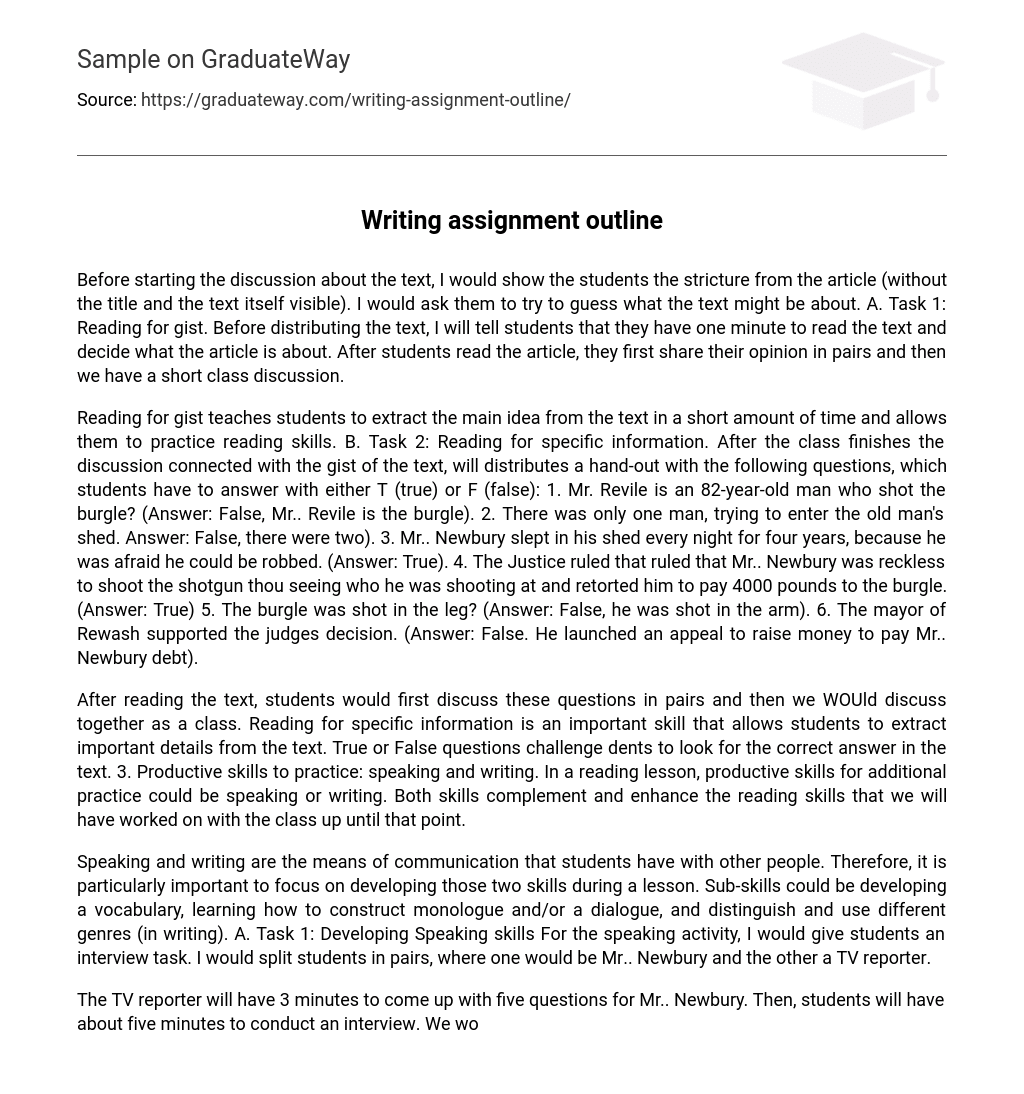Before starting the discussion about the text, I would show the students the stricture from the article (without the title and the text itself visible). I would ask them to try to guess what the text might be about. A. Task 1: Reading for gist. Before distributing the text, I will tell students that they have one minute to read the text and decide what the article is about. After students read the article, they first share their opinion in pairs and then we have a short class discussion.
Reading for gist teaches students to extract the main idea from the text in a short amount of time and allows them to practice reading skills. B. Task 2: Reading for specific information. After the class finishes the discussion connected with the gist of the text, will distributes a hand-out with the following questions, which students have to answer with either T (true) or F (false): 1. Mr. Revile is an 82-year-old man who shot the burgle? (Answer: False, Mr.. Revile is the burgle). 2. There was only one man, trying to enter the old man’s shed. Answer: False, there were two). 3. Mr.. Newbury slept in his shed every night for four years, because he was afraid he could be robbed. (Answer: True). 4. The Justice ruled that ruled that Mr.. Newbury was reckless to shoot the shotgun thou seeing who he was shooting at and retorted him to pay 4000 pounds to the burgle. (Answer: True) 5. The burgle was shot in the leg? (Answer: False, he was shot in the arm). 6. The mayor of Rewash supported the judges decision. (Answer: False. He launched an appeal to raise money to pay Mr.. Newbury debt).
After reading the text, students would first discuss these questions in pairs and then we WOUld discuss together as a class. Reading for specific information is an important skill that allows students to extract important details from the text. True or False questions challenge dents to look for the correct answer in the text. 3. Productive skills to practice: speaking and writing. In a reading lesson, productive skills for additional practice could be speaking or writing. Both skills complement and enhance the reading skills that we will have worked on with the class up until that point.
Speaking and writing are the means of communication that students have with other people. Therefore, it is particularly important to focus on developing those two skills during a lesson. Sub-skills could be developing a vocabulary, learning how to construct monologue and/or a dialogue, and distinguish and use different genres (in writing). A. Task 1: Developing Speaking skills For the speaking activity, I would give students an interview task. I would split students in pairs, where one would be Mr.. Newbury and the other a TV reporter.
The TV reporter will have 3 minutes to come up with five questions for Mr.. Newbury. Then, students will have about five minutes to conduct an interview. We would have a brief feedback session, where students share their questions and answers. This speaking activity takes reading the text to a different level, where students tot only will have to recall and use all the information in the text, but also to elaborate on the information and expand it further. Thus, speaking skills are enhanced and students’ creativity is engaged. . Task 2: Developing writing skills. Would ask students to imagine that they are one of the people who called (in their case, written) to The Times magazine to express an opinion about Mr.. Newbury case. I would ask them to write a letter to The Times, which addresses the following points: a. Do you agree or disagree with the ruling? B. State the reason for your opinion. C. What action are you going to take about the case (e. G. Donate money to help Mr.. Newbury pay off the bill; tell your friends about it, etc. ).
After students finish writing their letter, they share it with their partner first and do peer correction of grammatical and spelling mistakes. I will then stick all the letters on the wall and ask students to read them and vote for their favorite one. This writing activity allows students not only to work on their writing skills, but also be creative and take reading the text to a higher level (where they have to use the information in the text in a creative way). 4. The interrelation between receptive and productive skills J.
Harmer, in his book “The Practice of English Language Teaching,” states that “in many situations the production can only continue in combination with the practice of receptive skills. ” He goes on by saying: “The fact that reception and production are so bound together suggests strongly that we should not have students practice skills in isolation even if such a thing were possible. ” (Harmer 2001, p. 269). As Harmer suggests, it is very difficult to practice receptive and productive skills in isolation. In fact, each set of skills builds upon and enhances the other one.
For example, it is almost impossible (and not very productive) to practice reading in the SSL classroom situation without later discussing the text or writing about it. Similarly, if students are given a written task, it will only be logical that we will have an activity on reading what they have written in order to discuss (speaking) and do error correction. It is, therefore, essential for both teachers and students to understand that receptive and productive skills are interlinked and to try to take advantage of every opportunity to practice both sets of skills as often as possible.





